美国的高速铁路
- 格式:pdf
- 大小:649.42 KB
- 文档页数:35
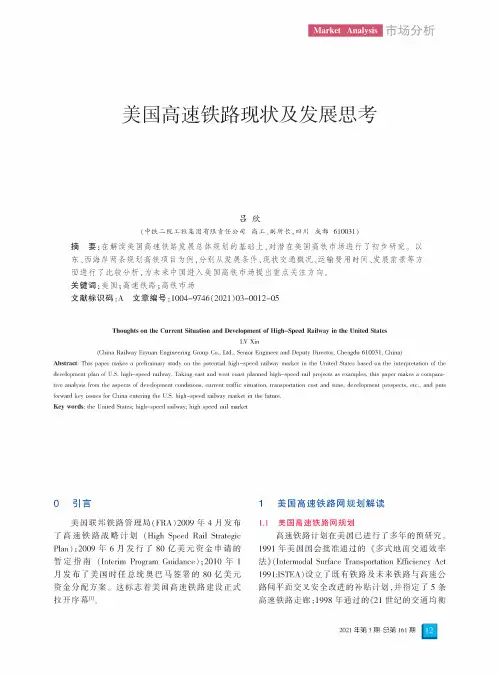
市场分析美国高速铁路现状及发展思考吕欣(中铁二院工程集团有限责任公司高工、副所长,四川成都610031)摘要:在解读美国高速铁路发展总体规划的基础上,对潜在美国高铁市场进行了初步研究。
以东、西海岸两条规划高铁项目为例,分别从发展条件、现状交通概况、运输费用时间、发展前景等方面进行了比较分析,为未来中国进入美国高铁市场提出重点关注方向。
关键词:美国;高速铁路;高铁市场文献标识码:A文章编号:1004-9746(2021)03-0012-05Thoughts on the Current Situation and Development of High-Speed Railway in the United StatesLV Xin(China Railway Eryuan Engineering Group Co.,Ltd.,Senior Engineer and Deputy Director,Chengdu610031,China)Abstract:This paper makes a preliminary study on the potential high-speed railway market in the United States based on the interpretation of the development plan of U.S.high-speed railway.Taking east and west coast planned high-speed rail projects as examples,this paper makes a comparative analysis from the aspects of development conditions,current traffic situation,transportation cost and time,development prospects,etc.,and puts forward key issues for China entering the U.S.high-speed railway market in the future.Key words:the United States;high-speed railway;high speed rail market0引言美国联邦铁路管理局(FRA)2009年4月发布了高速铁路战略计划(High Speed Rail Strategic Plan);2009年6月发行了80亿美元资金申请的暂定指南(Interim Program Guidance);2010年1月发布了美国时任总统奥巴马签署的80亿美元资金分配方案$这标志着美国高速铁路建设正式拉开序幕叫1美国高速铁路网规划解读1.1美国高速铁路网规划高速铁路计划在美国已进行了多年的预研究$ 1991年美国国会批准通过的《多式地面交通效率法》(Intermodal Surface Transportation Efficiency Act 1991:ISTEA"设立了既有铁路及未来铁路与高速公路间平面交叉安全改进的补贴计划,并指定了5条高速铁路走廊#1998年通过的《21世纪的交通均衡美国高速铁路现状及发展思考吕欣化法》(The Transportation Equity Act for the21st Century:TEA21)又指定了其他6条高铁走廊%目前,美国高铁路网规划全部依据立法规定的这11条高速铁路走廊制定,规划线路如表1所示。

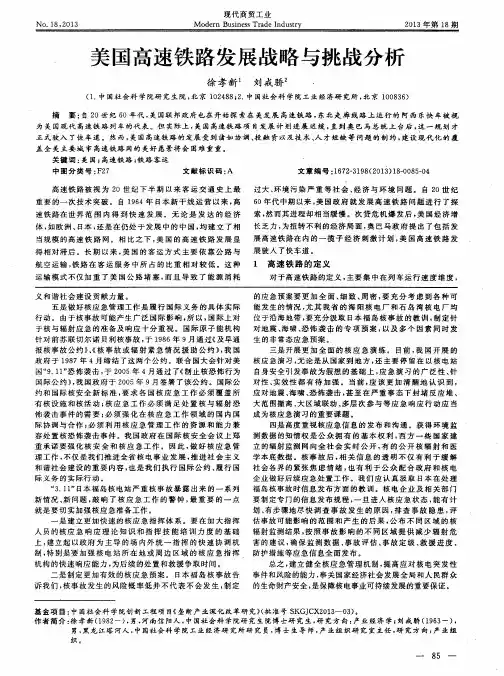
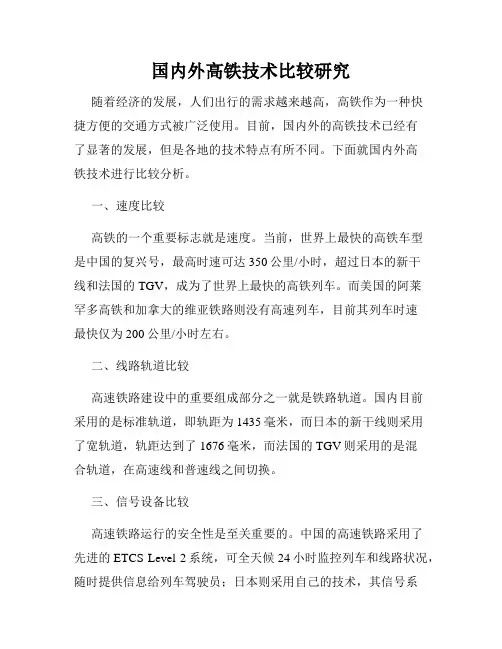
国内外高铁技术比较研究随着经济的发展,人们出行的需求越来越高,高铁作为一种快捷方便的交通方式被广泛使用。
目前,国内外的高铁技术已经有了显著的发展,但是各地的技术特点有所不同。
下面就国内外高铁技术进行比较分析。
一、速度比较高铁的一个重要标志就是速度。
当前,世界上最快的高铁车型是中国的复兴号,最高时速可达350公里/小时,超过日本的新干线和法国的TGV,成为了世界上最快的高铁列车。
而美国的阿莱罕多高铁和加拿大的维亚铁路则没有高速列车,目前其列车时速最快仅为200公里/小时左右。
二、线路轨道比较高速铁路建设中的重要组成部分之一就是铁路轨道。
国内目前采用的是标准轨道,即轨距为1435毫米,而日本的新干线则采用了宽轨道,轨距达到了1676毫米,而法国的TGV则采用的是混合轨道,在高速线和普速线之间切换。
三、信号设备比较高速铁路运行的安全性是至关重要的。
中国的高速铁路采用了先进的ETCS Level 2系统,可全天候24小时监控列车和线路状况,随时提供信息给列车驾驶员;日本则采用自己的技术,其信号系统具有极高的精度和实时性;法国的TGV则采用的是ATP信号系统,同样具有很高的安全性和精度。
四、动力车辆比较动力车辆也是高铁运行的重要组成部分。
中国的高速列车采用了世界领先的“电力集中控制”技术,列车可自动变更适应不同线路条件的动力输出,使运行更加稳定。
而日本的新干线采用的是磁浮技术,对轨道的要求非常高,但能够实现更加平稳的行车;法国的TGV则采用了电动机+变速器的组合。
五、设备制造比较高铁车辆的技术制造也是高铁建设中的重要部分。
中国的高速列车主要由中国南车、中国北车等公司制造;而日本新干线则由三菱重工业、川崎重工业以及日本车辆等公司联合制造;法国的TGV由阿尔斯通制造。
六、维护管理比较高铁的维护管理也是比较重要的。
中国的高速铁路维护管理由铁道部门负责,采用全方位的安全监测体系,以确保列车和线路的安全运行;日本的新干线则采用了“7S”(seiri、seiton、seiso、seiketsu、shitsuke、seitou、setsubi)管理方式,具有较强的组织管理能力;而法国的TGV则采用了“维修智能化”管理模式,通过先进的信息化技术,实现对列车运行状况的实时监控和预警。
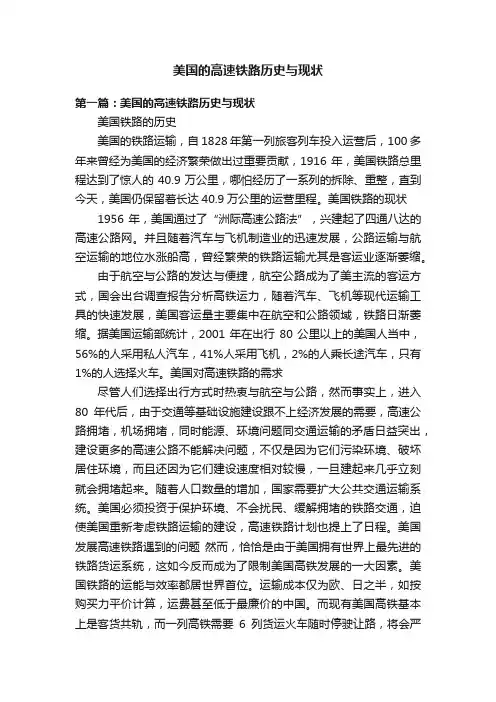
美国的高速铁路历史与现状第一篇:美国的高速铁路历史与现状美国铁路的历史美国的铁路运输,自1828年第一列旅客列车投入运营后,100多年来曾经为美国的经济繁荣做出过重要贡献,1916年,美国铁路总里程达到了惊人的40.9万公里,哪怕经历了一系列的拆除、重整,直到今天,美国仍保留着长达40.9万公里的运营里程。
美国铁路的现状1956年,美国通过了“洲际高速公路法”,兴建起了四通八达的高速公路网。
并且随着汽车与飞机制造业的迅速发展,公路运输与航空运输的地位水涨船高,曾经繁荣的铁路运输尤其是客运业逐渐萎缩。
由于航空与公路的发达与便捷,航空公路成为了美主流的客运方式,国会出台调查报告分析高铁运力,随着汽车、飞机等现代运输工具的快速发展,美国客运量主要集中在航空和公路领域,铁路日渐萎缩。
据美国运输部统计,2001年在出行80公里以上的美国人当中,56%的人采用私人汽车,41%人采用飞机,2%的人乘长途汽车,只有1%的人选择火车。
美国对高速铁路的需求尽管人们选择出行方式时热衷与航空与公路,然而事实上,进入80年代后,由于交通等基础设施建设跟不上经济发展的需要,高速公路拥堵,机场拥堵,同时能源、环境问题同交通运输的矛盾日益突出,建设更多的高速公路不能解决问题,不仅是因为它们污染环境、破坏居住环境,而且还因为它们建设速度相对较慢,一旦建起来几乎立刻就会拥堵起来。
随着人口数量的增加,国家需要扩大公共交通运输系统。
美国必须投资于保护环境、不会扰民、缓解拥堵的铁路交通,迫使美国重新考虑铁路运输的建设,高速铁路计划也提上了日程。
美国发展高速铁路遇到的问题然而,恰恰是由于美国拥有世界上最先进的铁路货运系统,这如今反而成为了限制美国高铁发展的一大因素。
美国铁路的运能与效率都居世界首位。
运输成本仅为欧、日之半,如按购买力平价计算,运费甚至低于最廉价的中国。
而现有美国高铁基本上是客货共轨,而一列高铁需要6列货运火车随时停驶让路,将会严重影响货运效率。
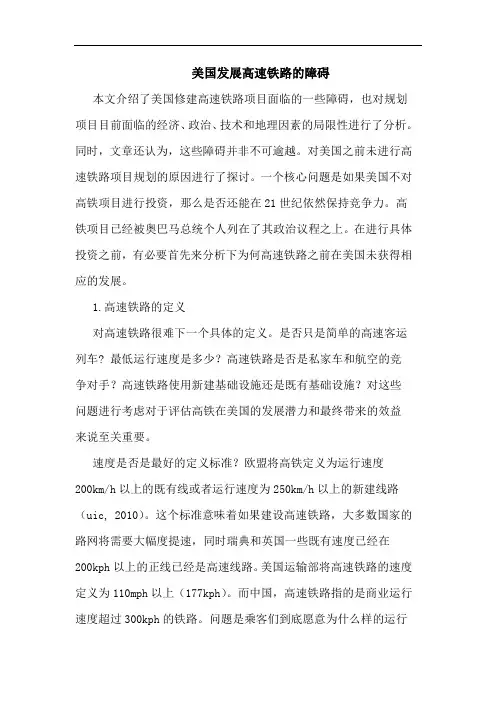
美国发展高速铁路的障碍本文介绍了美国修建高速铁路项目面临的一些障碍,也对规划项目目前面临的经济、政治、技术和地理因素的局限性进行了分析。
同时,文章还认为,这些障碍并非不可逾越。
对美国之前未进行高速铁路项目规划的原因进行了探讨。
一个核心问题是如果美国不对高铁项目进行投资,那么是否还能在21世纪依然保持竞争力。
高铁项目已经被奥巴马总统个人列在了其政治议程之上。
在进行具体投资之前,有必要首先来分析下为何高速铁路之前在美国未获得相应的发展。
1.高速铁路的定义对高速铁路很难下一个具体的定义。
是否只是简单的高速客运列车? 最低运行速度是多少?高速铁路是否是私家车和航空的竞争对手?高速铁路使用新建基础设施还是既有基础设施?对这些问题进行考虑对于评估高铁在美国的发展潜力和最终带来的效益来说至关重要。
速度是否是最好的定义标准?欧盟将高铁定义为运行速度200km/h以上的既有线或者运行速度为250km/h以上的新建线路(uic, 2010)。
这个标准意味着如果建设高速铁路,大多数国家的路网将需要大幅度提速,同时瑞典和英国一些既有速度已经在200kph以上的正线已经是高速线路。
美国运输部将高速铁路的速度定义为110mph以上(177kph)。
而中国,高速铁路指的是商业运行速度超过300kph的铁路。
问题是乘客们到底愿意为什么样的运行速度买单?高铁有多种经济模式。
中国、日本和台湾的高铁系统都采用新建的基础设施,主要是由于既有线路的轨距和供电系统不适应高速铁路。
西班牙的ave服务采取的是和日本相似的策略,修建单独标准轨距的高速铁路路网,供电线路为25kv。
路权的完全分离在日本和中国可以发挥重大作用,因为可以最大程度的发挥线路能力。
另外一种混合模式是同时使用既有线路和升级改造线路,在关键的通道和节点区域建设新线路。
这样的做法灵活性更高,并且可以将高铁车辆应用于那些新建基础设施在经济上不划算的地区,同时还可以在市中心人口密集区域运营高铁车辆,而不必进行过多的隧道工程和占用土地。
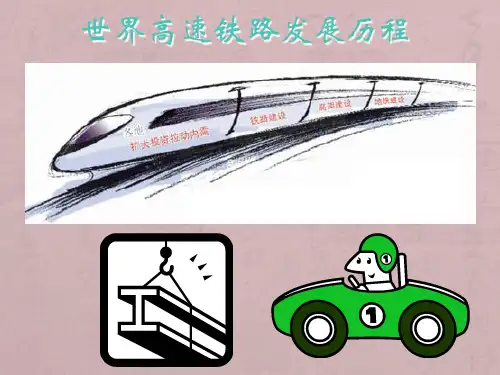
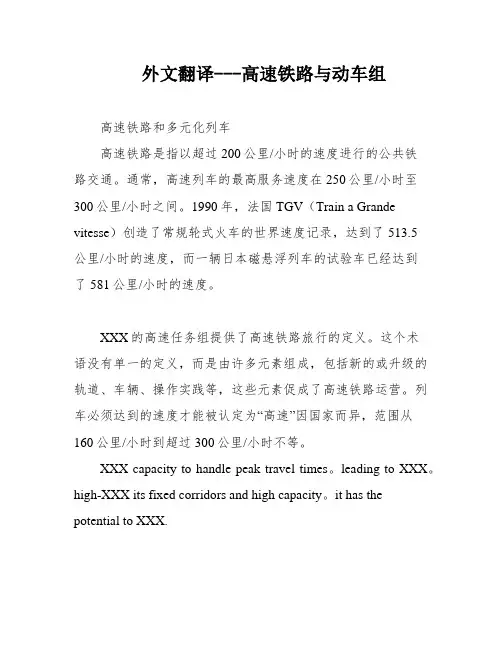
外文翻译---高速铁路与动车组高速铁路和多元化列车高速铁路是指以超过200公里/小时的速度进行的公共铁路交通。
通常,高速列车的最高服务速度在250公里/小时至300公里/小时之间。
1990年,法国TGV(Train a Grande vitesse)创造了常规轮式火车的世界速度记录,达到了513.5公里/小时的速度,而一辆日本磁悬浮列车的试验车已经达到了581公里/小时的速度。
XXX的高速任务组提供了高速铁路旅行的定义。
这个术语没有单一的定义,而是由许多元素组成,包括新的或升级的轨道、车辆、操作实践等,这些元素促成了高速铁路运营。
列车必须达到的速度才能被认定为“高速”因国家而异,范围从160公里/小时到超过300公里/小时不等。
XXX capacity to handle peak travel times。
leading to XXX。
high-XXX its fixed corridors and high capacity。
it has the potential to XXX.Before World War II。
nal passenger rail was the primary mode of XXX。
over time。
it has lost XXX。
high-XXX for passengers。
Overall。
it is clear that there are significant constraints on the growth of n systems。
XXX。
high-XXX challenges。
XXX。
As such。
it is likely to play an XXX.High-XXX faster speeds than cars。
XXX。
for journeys that do not connect city centers。
the total cost and door-to-door travel time of high-speed rail can be XXX driving。
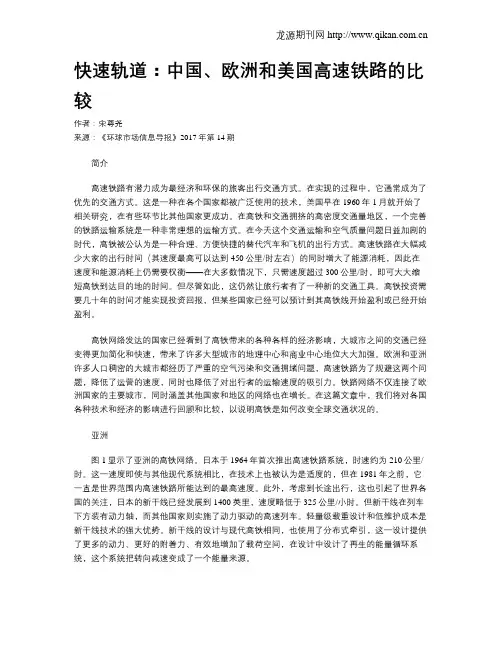
快速轨道:中国、欧洲和美国高速铁路的比较作者:宋尊尧来源:《环球市场信息导报》2017年第14期简介高速铁路有潜力成为最经济和环保的旅客出行交通方式。
在实现的过程中,它通常成为了优先的交通方式。
这是一种在各个国家都被广泛使用的技术,美国早在1960年1月就开始了相关研究,在有些环节比其他国家更成功。
在高铁和交通拥挤的高密度交通量地区,一个完善的铁路运输系统是一种非常理想的运输方式。
在今天这个交通运输和空气质量问题日益加剧的时代,高铁被公认为是一种合理、方便快捷的替代汽车和飞机的出行方式。
高速铁路在大幅减少大家的出行时间(其速度最高可以达到450公里/时左右)的同时增大了能源消耗,因此在速度和能源消耗上仍需要权衡——在大多数情况下,只需速度超过300公里/时,即可大大缩短高铁到达目的地的时间。
但尽管如此,这仍然让旅行者有了一种新的交通工具。
高铁投资需要几十年的时间才能实现投资回报,但某些国家已经可以预计到其高铁线开始盈利或已经开始盈利。
高铁网络发达的国家已经看到了高铁带来的各种各样的经济影响,大城市之间的交通已经变得更加简化和快速,带来了许多大型城市的地理中心和商业中心地位大大加强。
欧洲和亚洲许多人口稠密的大城市都经历了严重的空气污染和交通拥堵问题,高速铁路为了规避这两个问题,降低了运营的速度,同时也降低了对出行者的运输速度的吸引力。
铁路网络不仅连接了欧洲国家的主要城市,同时涵盖其他国家和地区的网络也在增长。
在这篇文章中,我们将对各国各种技术和经济的影响进行回顾和比较,以说明高铁是如何改变全球交通状况的。
亚洲图1显示了亚洲的高铁网络。
日本于1964年首次推出高速铁路系统,时速约为210公里/时。
这一速度即使与其他现代系统相比,在技术上也被认为是适度的,但在1981年之前,它一直是世界范围内高速铁路所能达到的最高速度。
此外,考虑到长途出行,这也引起了世界各国的关注,日本的新干线已经发展到1400英里,速度略低于325公里/小时。

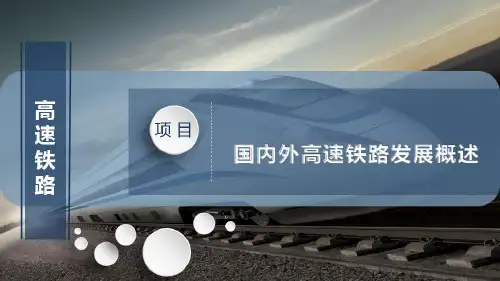
高速铁路-项目-国内外高速铁路发展概述1.1国外高速铁路概况-1.世界高速铁路的发展建设高潮-自日本东海道新干线开通以来,法国、德国日本、西班牙、意大利、比利时、英国、瑞典、丹-麦和韩国等国家都已拥有高速铁路,还有多个国家正在建高速铁路。
回顾世界高速铁路的发展-历史,可以看到高速铁路经历了3次主要的建设高潮。
1.1国外高速铁路概况-1.世界高速铁路的发展建设高潮-1第一次建设高潮1964一1990年。
964年10月,日本东海道新千线正式通车,该线从-东京起始,途经名古屋、京都等地终至(新)大阪全长515.4km,运营速度高达210km/h。
-东海道新干线高速铁路建设成就显著,在技术、商、财政以及运行效益和社会效益上都获得了-极大的成功。
日本于1971年通过了新干线建设法,并对全的高速铁路网建设做出规划,开始向-全国普及发展。
日本于1972年又修建了山阳、东北和上越新干线1.1国外高速铁路概况-1.世界高速铁路的发展建设高潮-日本新干线的成功建设给欧洲国家以巨大冲,各国纷纷修建高速铁路。
1981年,法国高速铁路-TGV在巴黎和里昂之间开通,如今已形成以巴黎中心、辐射法国各城市及周边国家的铁路-网络。
此后,德国开发了高速铁路系统,意大利修建了罗马一佛伦萨线。
1986年,意大利政府-批准了交通运输发展规划纲要,计划修建横连东西、纵贯南北、长达130k的T形高速铁路网1.1国外高速铁路概况-1.世界高速铁路的发展建设高潮-为赶超日本,法国和德国先后着手开展高速路试验。
1981年,法国TGV列车的最高试验速度达-到380km/h;1988年,德国LCE列的最高试验速度达到406.9km/h;1990年,法国TGV列车-又创造了515.3km/h的界纪录。
欧洲国家高速铁路技术的进展反过来又"刺激”了日本,使之-加强了技术研究和新型车辆的开发山阳新干线和东海道新干线的运行速度分别提高到275k/h-和300k/h。
飞机:纽约有三大机场,肯尼迪国际机场(JFK)、拉瓜迪亚机场(LGA)以及纽瓦克自由国际机场(EWR)。
一般从中国起飞前往纽约的国际航班都会在肯尼迪机场降落,少部分会在纽瓦克机场降落。
而拉瓜迪亚机场更多的是接待美国国内航线。
,IATA:JFK,肯尼迪国际机场(John F. Kennedy International AirportICAO:KJFK,FAA:JFK):约翰·菲茨杰拉德·肯尼迪国际机场(英文:John F. Kennedy International Airport)是纽约市的主要国际机场,距离曼哈顿下城19公里(12英里)。
也是全世界最大机场之一,位于纽约皇后区(昆斯区)牙买加湾之滨。
机场由纽约与新泽西港口管理局运营,管理局同时还管理拉瓜地亚机场、纽瓦克自由国际机场等大纽约都会区的机场。
机场内有超过90间航空公司营运。
肯尼迪国际机场是捷蓝航空的枢纽机场,也是美国航空和达美航空主要国际航班的枢纽机场。
肯尼迪国际机场是美国航空第四个枢纽机场和达美航空第五个枢纽机场。
过去,这机场是东方航空、国家航空、泛美航空和环球航空的枢纽机场。
纽瓦克自由国际机场(亦译为纽华克自由国际机场,英文:Newark Liberty,IATA:EWR,ICAO:KEWR):International Airport位于美国新泽西州纽瓦克市与伊丽莎白市境内,距纽约州纽约市曼哈顿约16英里(26千米)路程。
纽瓦克机场是纽约都会区的三大机场之一,这三大机场均由纽约新泽西港务局管理。
纽瓦克机场是全美第10大繁忙的机场,以及全美第5大国际直飞机场。
,IATA:LGA:ICAO:KLGA:拉瓜迪亚机场(英文:LaGuardia AirportFAA:LGA):是美国纽约市的三大机场之一,位于皇后区,面向法拉盛湾。
此机场是以命名。
目前,机场是由纽前纽约市长菲奥雷洛·H·拉瓜迪亚(Fiorello LaGuardia)约与新泽西港口管理局负责管理及营运,此管理局同时也管理营运纽约市的肯尼迪国际机场和纽瓦克自由国际机场。
世界高速列车概况(一)高速铁路根据UIC(国际铁路联盟)的定义,高速铁路是指透过改造原有线路(直线化、轨距标准化),使营运速率达到每小时200公里以上,或者专门修建新的“高速新线”,使营运速率达到每小时250公里以上的铁路系统。
早在20世初前期,当时火车“最高速率”超过时速200公里者比比皆是。
直到1964年日本的东海道新干线系统开通,是史上第一个实现“营运速率”高于时速200公里的高速铁路系统。
高速铁路除了在列车营运速度达到一定标准外,车辆、路轨、操作都需要配合提升。
广义的高速铁路包含使用磁悬浮技术的高速轨道运输系统。
在中国,时速高达200或以上,并使用CRH和谐号列车称为“动车组”,时速160-200公里的城际列车称为“准高速”及长途列车称为“特快”,120-160称为“快速”,120以下的称为“普快”,80或以下为“普客列车”。
法国自主技术的法国TGV铁路是人类发明的首项公共交通工具,在19世纪初期便在英国出现。
直至20世纪初发明汽车,铁路一向是陆上运输的主力。
二次大战以后,汽车技术得到改进、高速公路亦大量建成,加上民航的普及,使铁路运输慢慢走向下坡。
特别在美国,政府的投资主要放在公路建设上,不少城市内的公共交通曾一度被遗弃。
如此的思维也影响不少地区,例如二次大战后的台湾及美占时期的冲绳。
世界上首条投入商业运作的高速铁路是日本的东海道新干线,于1964年东京奥运前夕正式营运。
第一代新干线列车主要由川崎重工业建造,行驶在东京—名古屋-京都-新大阪的东海道新干线,营运速度超过每小时200公里。
日本新干线300及700系高速铁路与汽车及民航无论是高速公路或机场都得面对挤塞的问题。
高速铁路的优点是载客量非常高,因此得以快速代谢乘客。
倘若旅程非以大城市中心为出发及目的地,使用高速铁路加上转乘的时间可能只跟驾驶汽车相若。
但高速铁路毋须自行驾车会较为舒适。
另一方面,虽然高速铁路的速度比不上飞机,但在距离稍短的旅程(650公里以下),高速铁路因无需到一般较为遥远的机场登机,亦减省了提早划位、安检、等待登机之程序,因而仍较为省时。
美、日、俄、印国家铁路发展概况窦桂丽1戴新鎏2孙晓峰3(1、2铁道部经济规划研究院副研究员;3铁道部经济规划研究院助理研究员,北京100038)摘要:结合美国、日本、俄罗斯、印度等国铁路现状,分析各国铁路发展特色,以供我国大规模铁路建设借鉴。
关键词:铁路:发展特色:美国:日本:俄罗斯:印度文献标识码:A文章编号:1004—9746(2009)02—0007一04Abstract:ThearticleanalyzesthecharacteristicsofrailwaydevelopmentinUSA,Japan,RussiaandIndia,whichserves聃referencefornationalrailwayconstruction.Keywords:railway;characteristics;USA;Japan;Russia;India由于自然资源、产业布局、人口分布、地理环境、文化风俗以及经济社会发展水平不同,世界各国铁路各有其鲜明特点。
美国国土面积与我国相当,铁路网规模居世界之首,是我国既有铁路网规模的3倍多;俄罗斯铁路网规模居世界第二;印度国土面积仅为我国的1/3多,而铁路网规模仅次于我国,列居世界第四;13本是第一个建成高速铁路的国家,高速铁路网规模列世界之首。
这四个国家铁路的发展各具特色,在我国大规模铁路建设中值得借鉴。
1美国铁路美国国土面积962.9万km2,人口为3亿。
19世纪下半叶,通过“私人投资、政府援助”的方式,铁路建设取得了很大的成功。
拥有世界上最大的铁路网,铁路建设的成功为美国经济的高速发展奠定了坚实基础。
美国铁路以货运为主,承担的货物周转量份额一直保持在40%左右。
重载运输、集装箱运输在铁路货物运输中得到广泛应用。
1.1铁路现状美国第一条铁路始建于1827年。
1860年,路网快速扩展到50274km。
1916年,美国铁路总里程达到历史最高峰,共408745km。
美国铁路的历史美国的铁路运输,自1828年第一列旅客列车投入运营后,100多年来曾经为美国的经济繁荣做出过重要贡献,1916年,美国铁路总里程达到了惊人的40.9万公里,哪怕经历了一系列的拆除、重整,直到今天,美国仍保留着长达40.9万公里的运营里程。
美国铁路的现状1956年,美国通过了“洲际高速公路法”,兴建起了四通八达的高速公路网。
并且随着汽车与飞机制造业的迅速发展,公路运输与航空运输的地位水涨船高,曾经繁荣的铁路运输尤其是客运业逐渐萎缩。
由于航空与公路的发达与便捷,航空公路成为了美主流的客运方式,国会出台调查报告分析高铁运力,随着汽车、飞机等现代运输工具的快速发展,美国客运量主要集中在航空和公路领域,铁路日渐萎缩。
据美国运输部统计,2001年在出行80公里以上的美国人当中,56%的人采用私人汽车,41%人采用飞机,2%的人乘长途汽车,只有1%的人选择火车。
美国对高速铁路的需求尽管人们选择出行方式时热衷与航空与公路,然而事实上,进入80年代后,由于交通等基础设施建设跟不上经济发展的需要,高速公路拥堵,机场拥堵,同时能源、环境问题同交通运输的矛盾日益突出,建设更多的高速公路不能解决问题,不仅是因为它们污染环境、破坏居住环境,而且还因为它们建设速度相对较慢,一旦建起来几乎立刻就会拥堵起来。
随着人口数量的增加,国家需要扩大公共交通运输系统。
美国必须投资于保护环境、不会扰民、缓解拥堵的铁路交通,迫使美国重新考虑铁路运输的建设,高速铁路计划也提上了日程。
美国发展高速铁路遇到的问题然而,恰恰是由于美国拥有世界上最先进的铁路货运系统,这如今反而成为了限制美国高铁发展的一大因素。
美国铁路的运能与效率都居世界首位。
运输成本仅为欧、日之半,如按购买力平价计算,运费甚至低于最廉价的中国。
而现有美国高铁基本上是客货共轨,而一列高铁需要6列货运火车随时停驶让路,将会严重影响货运效率。
美国高铁计划的问题并非出于自己的谨慎小心,而是万一为实现这点抱负铤而走险,有可能将铁路货运的巨大成功付诸东流。
美国铁路现状调研王开锋**************************一、美国铁路路网根据2007年统计数据,美国铁路里程为226,427公里。
20世纪80年代中期至本世纪初,美国铁路货运收入一直呈上升趋势,而每吨公里的雇员数量却大幅下降。
北美铁路网拥有7个Ⅰ级铁路公司、数百个Ⅱ级区域性铁路公司和Ⅲ级短途铁路公司。
1.货运公司根据年营业收入,北美拥有7个Ⅰ级铁路公司(年收入大于4亿美元),分别为:➢Union Pacific(联合太平洋公司)➢BNSF➢CSX➢Norfolk Southern(诺福克南方公司)➢Kansas City Southern(堪萨斯市南方公司)➢Canadian Pacific(加拿大太平洋公司)➢Canadian National(加拿大国家公司)根据2011年统计数据,7个Ⅰ级铁路公司共有营运机车24,250台,货物车辆380,699台,雇员158,623人,其路网如图1所示。
图1 北美7个Ⅰ级铁路公司根据2012年统计数据,北美铁路主要运输的货物为煤炭(43.3%)、化工产品(10.3%)、农产品(8.3%)等,如图2所示。
图2 2012年AAR政策与经济研究部门统计结果(1)联合太平洋铁路公司(UP)联合太平洋铁路公司成立于1862年,是北美最大的铁路公司,拥有51499km正线、19703km站场、侧线及工厂线,雇员约4.5万人,年收入195亿美元,在财富500强中排名143位。
截止2013年10月,拥有8185辆机车。
(2)加拿大太平洋铁路公司(CP)加拿大太平洋铁路公司是北美第6大铁路公司,拥有25,560km线路、16,097雇员、年营收52亿美元。
(3)诺福克南方铁路公司(NS)总部位于弗吉尼亚州的诺福克市。
铁路总里程达34,600km,服务于美国东部22个州及华盛顿哥伦比亚特区和加拿大安大略省。
截止2013年,拥有4,074辆机车、30,943名雇员。
High Speed Rail (HSR) in the United States David Randall Peterman, CoordinatorAnalyst in Transportation PolicyJohn FrittelliSpecialist in Transportation PolicyWilliam J. MallettSpecialist in Transportation PolicyDecember 8, 2009Congressional Research Service7-5700R40973 CRS Report for CongressSummaryCongress has been interested in high speed rail (HSR) since the 1960s, but the provision of$8 billion for intercity passenger rail and high speed rail projects in the American Recovery and Reinvestment Act (ARRA; P.L. 111-5), enacted in February 2009, has catalyzed enthusiasm for high speed rail in Congress and the nation. One consequence has been a proposed authorization of $50 billion for intercity passenger rail development (including high speed rail) as part of new surface transportation authorization legislation. There have been other periods of interest in HSR on the part of Congress and various states over the past few decades; they largely faded in the face of obstacles such as the high cost of HSR and policies supporting other modes of transportation. Comparing the costs and benefits of investing in one mode versus another is typically not a part of transportation funding decisions.There are two approaches to HSR: improving existing tracks and signaling to allow trains to travel somewhat faster, typically to as much as 110 miles per hour (mph), generally on track shared with freight trains; and building new tracks dedicated exclusively to high speed passenger rail service, to allow trains to travel at speeds of 200 mph or more. The potential costs, and benefits, are relatively lower with the first approach and higher with the second approach. Current discussions of high speed rail programs and policies sometimes fail to clearly distinguish between these two approaches.There are a handful of routes in the United States where track has been improved to allow service at up to 110 mph, and there are a few places along Amtrak’s Northeast Corridor where speeds of up to 150 mph are achieved for a relatively short distance. But there are no dedicated high speed lines in the United States comparable to those in Europe and Asia, on which trains travel at sustained speeds of over 150 mph.Estimates of the cost of constructing HSR vary according to the speed sought, the geography of the corridor, the cost of right-of-way, and other factors. Construction costs likely increase with population density, but this high fixed-cost technology depends on density for higher usage rates. Experts say that virtually no HSR lines anywhere in the world have earned enough revenue to cover both their construction and operating costs, even where population density is far greater than anywhere in the United States. Typically, governments have paid the construction costs, and in many cases have subsidized the operating costs as well.Proponents of HSR contend that it offers benefits to society at large, not just to its passengers: that it can be a more energy efficient and less polluting transportation alternative compared to aviation and highway travel (and is safer than driving). They also cite its potential to relieve congestion on highways and in the aviation system; its potential contribution to economic development; and the potential job-creating impact of constructing high speed lines. Others question whether these potential social benefits are commensurate with the likely costs, and whether a national HSR network is a practical transportation option for the United States, given the nation’s large size and relatively low population density.In light of the lack of experience with high speed rail development in the United States, HSR projects are likely to face many challenges, including securing adequate funding over the long term and complexity of implementation. Given the variety of arguments both for and against high speed rail, and the costs of high speed rail in light of the constrained federal budget, Congress may wish to carefully consider further investment in high speed rail.ContentsIntroduction (1)What is High Speed Rail? (1)High Speed Rail Options (3)Components of a High Speed Rail System (3)Conventional High Speed Rail (4)Track (4)Signal and Communications Networks (5)Magnetic Levitation (Maglev) (5)High Speed Rail In Other Countries (6)Japan (7)France (8)Germany (8)Spain (9)China (9)Background of Intercity Passenger Rail in the United States (9)Previous High Speed Rail Efforts in the United States (10)Recent Congressional Initiatives to Promote High Speed Rail (12)Potential Benefits of High Speed Passenger Rail (14)Alleviating Highway and Airport Congestion (14)Alleviating Pollution and Reducing Energy Consumption by the TransportationSector (16)Promoting Economic Development (17)Improving Transportation Safety (18)Providing Travelers a Choice of Modes (18)Making the Transportation System More Reliable (19)High Speed Rail Cost Issues (19)Infrastructure Costs (19)Operating Costs (22)Ridership Potential (23)High Speed Rail Funding Considerations (25)Considerations for Congress (28)FiguresFigure A-1. Map of Federally Designated High Speed Rail Corridors (30)TablesTable 1. Statutory Definitions of High Speed Rail (2)Table 2. Categories of High Speed Rail in FRA’s “Vision for High-Speed Rail in America” (2)Table 3. High Speed Rail Corridors in the United States (11)Table 4. Recent Congressional Initiatives Related to High Speed Rail (13)Table 5. Densest Air Travel City Pairs Within About 500 Miles Distance (24)AppendixesAppendix. Federally Designated High Speed Rail Corridors (30)ContactsAuthor Contact Information (31)IntroductionWhile Congress has been interested in high speed rail (HSR) since the 1960s, the provision of $8 billion for intercity passenger rail projects in the American Recovery and Reinvestment Act (ARRA; P.L. 111-5), enacted in February 2009, has invigorated the prospect of high speed passenger rail transportation in the United States. As one industry observer has noted, “it is impossible to overstate how big a sea change this represents ... [the] $8 billion is seventeen times as much money as Congress has provided for these programs over the past 10 fiscal years.”1 The $8 billion was included in ARRA largely at the behest of President Obama, and a subsequent announcement in April 2009 made it clear that the development of high speed rail is to be a priority of his Administration. At the April announcement, the Obama Administration released a strategic plan for high speed rail, including a proposal for budgeting an additional $1 billion a year for five years. The plan identifies the funding as “a down payment to jump-start a potential world-class passenger rail system and sets the direction of transportation policy for the future.”2 In addition to the work being done by the Administration, there has been a flurry of activity within Congress and in the transportation community to define what such a system should look like, where it should go, how much should be spent on it, and where that funding should come from. Leadership of the House Transportation and Infrastructure Committee, for example, has suggested including $50 billion for high speed rail in a six-year reauthorization of the surface transportation programs.3This report provides an overview of high speed rail in the United States. It discusses definitions of high speed rail, looks at high speed rail in selected other countries, and describes congressional initiatives to promote HSR, including provisions in the Passenger Rail Investment and Improvement Act of 2008 (P.L. 110-432) and ARRA. The report then surveys rationales for developing HSR, cost estimates for HSR, and some of the challenges expected in implementing HSR.What is High Speed Rail?There is no authoritative definition of what constitutes high speed rail. The European Union defines HSR as•Separate lines built for speeds of 250 kilometers per hour (kph) (150 mph), or•Existing lines upgraded to speeds of 200 kph (125 mph), or•Upgraded lines whose speeds are constrained by circumstances such astopography or urban development.41Transportation Weekly, “President to Sign Stimulus Bill Today,” February 17, 2009, p. 5.2 U.S. Department of Transportation, “President Obama, Vice President Biden, Secretary LaHood Call for U.S. High-Speed Passenger Trains,” Press Release, Thursday April 16, 2009, DOT 51-09, /Downloads/ RRdev/hsrpressrelease.pdf.3 For information about surface transportation authorization proposals, see CRS Report R40780, Surface Transportation Reauthorization Legislation in the 111th Congress: Summary of Selected Major Provisions, coordinated by John W. Fischer.4 International Union of Railways, “General Definitions of Highspeed,” available at http://www.uic.asso.fr/gv/ article.php3?id_article=14.The U.S. government also has several definitions of what constitutes high speed rail. The Department of Transportation’s (DOT) Federal Railroad Administration (FRA) has defined high speed rail as service “that is time-competitive with air and/or auto for travel markets in the approximate range of 100 to 500 miles.”5 As FRA notes, this is a market-driven definition which recognizes that, in choosing a transportation mode, travelers are more interested in total trip time than in top speed, and that travelers evaluate transportation modes not in isolation, but by how those modes compare to each other.Congress has, at different times, established high speed rail funding programs using different speed-based definitions and eligibility criteria (see Table 1).T able 1. Statutory Definitions of High Speed RailStatute Speed Component of DefinitionHigh Speed Rail Assistance (enacted 1994) “reasonably expected to reach sustained speeds of morethan 125 miles per hour” (49 USC §26105)High speed rail corridor development program (enacted 2008) “reasonably expected to reach speeds of at least 110 miles per hour” (49 USC §26106(b)(4))Railway-highway crossing hazard elimination in high speed rail corridors program (enacted 1991) “where railroad speeds of 90 miles or more per hour are occurring or can reasonably be expected to occur in the future” (23 USC §104(d)(2)(C)Source: CRS.In its strategic plan for high speed rail, which Congress required to be issued within 60 days ofpassage of ARRA, FRA defines three categories of high speed rail corridors. These categories aredefined in terms of top speeds as well as track characteristics and service frequency (see Table 2).T able 2. Categories of High Speed Rail in FRA’s“Vision for High-Speed Rail in America”Category SpeedCharacteristics Emerging High Speed Rail Top speeds of 90-110 mph.Regional High Speed Rail Top speeds of 110-150 mph on grade-separated track.Express High Speed Rail Top speeds of at least 150 mph on grade-separated trackdedicated to passenger service.Source: Federal Railroad Administration, Vision for High-Speed Rail in America, April 2009, p. 2,/Downloads/Final%20FRA%20HSR%20Strat%20Plan.pdf.As the various definitions of high speed rail show, discussions of high speed rail in the UnitedStates can refer to trains traveling at speeds of 90 mph on tracks shared with freight trains ortrains traveling over 200 mph on dedicated track, or both, and it is not always clear from thecontext what category of high speed rail is meant. To try to distinguish between the differentcategories of high speed rail, in this report the term “higher speed rail” will refer to HSR onshared tracks with speeds up to 150 mph (encompassing both FRA’s “Emerging HSR” and5 Department of Transportation, Federal Railroad Administration, High-Speed Ground Transportation for America,September 1997, p. 2-2.“Regional HSR” classifications), and “very high speed rail” will refer to HSR on dedicated tracks with speeds over 150 mph (equivalent to FRA’s “Express HSR” classification).High Speed Rail OptionsThere are two options to developing high speed rail service; the option chosen determines the level of high speed service that can be attained:•Upgrading existing track, signaling systems, and equipment (e.g., tilting trains) to enable trains to travel somewhat faster over the existing rail network, or •Building new rail lines enabling trains to travel at much higher speeds than are possible over the existing rail network, which is shared with freight rail.The advantage of upgrading existing track is its lower cost; one estimate puts the average cost of such upgrades at around $7 million per mile.6 One limitation of that approach is that the existing network usually has many limitations on train speed—curves, at-grade road crossings, etc.—that limit the potential speed improvements. For example, in the 1990s Amtrak (and commuter railroads7) spent around $2 billion—an average of around $9 million per mile, in 2003 dollars—to upgrade the 229-mile north end of the Northeast Corridor (connecting Boston to New York City), including electrifying the route and replacing a bridge.8 This reduced rail travel time between Boston and New York City from 4 hours to 3 hours and 24 minutes—an increase in average speed over the route from 57 mph to 67 mph.Conversely, building new rail lines makes much higher speeds possible—up to 200 mph or more. One limitation of that approach is the cost, which is estimated to average $35 million per mile,9 or more in densely populated areas or difficult terrain.Components of a High Speed Rail SystemHigh speed rail is correctly viewed as a system made up of several components, including the train, the track, and the signal and communications network. High speed rail can use either conventional steel wheel on steel rail technology, or magnetic levitation (in which superconducting magnets levitate a train above a guide rail), commonly referred to as “maglev.”6 Passenger Rail Working Group of the National Surface Transportation Policy and Revenue Study Commission, Vision for the Future: U.S. Intercity Passenger Rail Network Through 2050, December 6, 2007, p. 31.7 Amtrak owns only 363 of the 457 miles of the Northeast Corridor; the remainder is owned by a number of states and commuter rail agencies. Douglas John Bowen, “Amtrak’s NEC: healthy hybrid: the Western Hemisphere’s busiest passenger rail route delivers a dazzling array of service unequalled by more glamorous global counterparts,” Railway Age, August 2008.8 Government Accountability Office, Intercity Passenger Rail: Amtrak’s Management of Northeast Corridor Improvements Demonstrates Need for Applying Best Practices, GAO-04-94, February 27, 2004, pps. 19-20.9 Passenger Rail Working Group, op. cit., p 31.Conventional High Speed RailWith one minor exception, all current high speed rail systems use conventional steel wheel on steel rail technology. At speeds up to around 125 mph, these trains can be pulled by diesel-electric locomotives. For higher speeds, trains powered by externally supplied electricity become necessary. These trains’ engines draw power from electricity transferred from overhead wires (catenary). This technology allows for lighter-weight trains, in part because they do not have to carry fuel. Because of their lighter weight, these trains can stop and start more quickly and produce less wear on the track. While these trains typically operate at speeds of up to 210 mph, their potential speed is much greater. In 2007 a French electric-powered train set a new speed record for a train on conventional tracks, traveling 357 mph.10 That is only slightly below the speed record for any type of train, 361 mph, set by a Japanese maglev train in 2003. Because of the greater costs, and relatively minor benefits,11 of operating at extremely high speeds, the top operating speed of most conventional high speed trains is limited to around 210 mph.There are two main reasons why such trains are not widely available in the United States. First, only a small portion of the U.S. rail network is electrified, so most passenger trains must use diesel-electric locomotives. Second, because passenger trains typically use the same tracks as freight trains (and neither generally use the most advanced collision avoidance systems), federal regulations require that passenger trains have a variety of design features to protect passengers in the event of a train crash. This results in relatively heavy passenger trains, which are thus slower to get up to speed and take longer to stop.TrackTo make high speed operation possible, rail track must be substantially flat and straight, with shallow curves and gentle changes in elevation. As train speeds increase, the risk of crashes at intersections where roads cross the rail line (“at-grade crossings”) increases, so safety dictates that higher speed tracks not have any at-grade crossings.12 This is the standard to which new high speed lines in other countries are usually built. The result is the rail equivalent of the Interstate Highway System, allowing trains to operate at high average speeds without risk from crossing traffic. Such lines are usually restricted to the use of high speed passenger trains, so that the trains do not conflict with slower passenger or freight trains.A high speed rail system using dedicated track can handle many trains at one time without compromising safety. For example, the Japanese high speed rail network, which began operation in 1964, now has trains running at speeds up to 200 mph, with as little as three minutes of headway (the time separating trains operating on the same track) during peak periods. In more than 40 years of operation, there has never been a fatality due to a train crash on the Japanese high speed network.1310 Ariane Bernard, “French Train Breaks Rail Speed Record,” New York Times, April 4, 2007.11 As train speeds increase, the benefit of even greater speeds diminishes. For example, increasing the average speed ona 240-mile route from 60 mph to 120 mph reduces the trip time by 2 hours, from 4 hours to 2; the next 60-mph increase, from 120 mph to 180 mph, only reduces the trip time by 40 minutes; the next 60 mph increase beyond that, from 180 mph to 240 mph, would only reduce the trip time by 20 minutes.12 Federal Railway Administration regulations require that rail lines rated for speeds above 150 mph have no at-grade crossings. 49 CFR 213.347(a).13 Christopher P. Hood, “Biting the Bullet: What We Can Learn from the Shinkansen,” Electronic Journal of (continued...)Signal and Communications NetworksBecause trains operate on a fixed track, and generally at speeds that do not allow them to stop within the sight distance of the train operator, the risk of collision is ever-present, and safety requires some way to track and communicate with many trains at once. The prevailing train control system on the U.S. rail network is based on train dispatchers at central locations who track the location of trains and signal to train operators when it is safe to proceed onto a stretch of track. This system is somewhat analogous to the air traffic control system, in that the dispatchers can see the location of trains but cannot directly control those trains. Thus, when a train operator does not respond correctly to an operational signal, a collision may occur.High speed rail networks use electronic train control systems (often referred to as “positive train control,” or PTC). This technology is intended to increase the efficiency of operation and reduce the risk of crashes by providing better signal performance and protecting against human error in the operation of the trains. Outside of the NEC, almost none of the nation’s rail network is equipped with positive train control. However, the Rail Safety Improvement Act of 2008 requires that rail carriers implement positive train control by December 31, 2015, on main lines over which passengers or poison- or toxic-by-inhalation hazardous materials are transported.14 Magnetic Levitation (Maglev)Maglev train technology was developed in the United States in the 1960s. It uses electromagnets to suspend (levitate) the train above a guideway, as well as to propel the train. By eliminating contact (and hence friction) between the train and the guideway, maglev trains can go very fast, and the trains and tracks are expected to experience less wear and tear, thus reducing maintenance costs, though there is not enough experience with maglev in commercial operations to verify this. People have talked about the potential of maglev trains for decades, but maglev projects face a number of obstacles. One is that maglev lines are not compatible with conventional train technology, so a maglev line cannot be added as part of an existing rail network. Also, although the costs of constructing and maintaining a maglev line are not clear, as very few maglev projects have ever been built, it is generally believed that such projects are very expensive. Japan and Germany have both had maglev test tracks in operation since the 1970s and 1980s, respectively, but neither country has gone on to build the commercial maglev lines that were envisioned. Congress established a program to promote the development of maglev lines in the United States in the 1990s, but none of the projects that received support from the program have advanced beyond the planning stage. As of 2009 there is only one commercial maglev system in operation in the world, a 19-mile line completed in 2004 in China, connecting an outlying station on Shanghai’s subway network to the Pudong International Airport. That train, based on German maglev technology, reaches 268 mph in normal operation, though it has a demonstrated top speed of 311 mph.(...continued)Contemporary Japanese Studies, May 23, 2001.14 P.L. 110-432, Division A, §104.Since conventional train technology is capable of speeds comparable to maglev technology, and the costs of maglev implementation are uncertain, but probably very high, there is little impetus to adopt maglev technology. Moreover, as a different type of rail technology, maglev would not connect to the existing rail network, but would involve creating an entirely separate rail network. China reportedly built the Shanghai line in part to examine maglev technology as a candidate for high speed lines it planned; it subsequently decided to use conventional train technology for its high speed rail network. However, the Central Japan Railway Company (JR Central) has announced that it will expand the capacity on its aging high speed line between Tokyo and Osaka, the most heavily traveled intercity rail segment in the world, by building a maglev line between Tokyo and Nagoya, which is approximately two-thirds of the way to Osaka. The planned train would travel at 300 mph over the 175-mile route. Due in part to the geographic constraints—as the line would pass through mountainous areas, as well as densely populated areas, about 80% of the line would be located underground or in tunnels—JR Central estimated the cost of building the guideway alone at 5.1 trillion yen (around $50 billion), or a little less than $300 million per mile. It is not certain that the line will be built; observers have cautioned that the costs could rise, and that the need for the new line is unclear, given forecasts that Japan’s population may begin to decline in coming years.15High Speed Rail In Other CountriesOne of the basic obstacles facing development of high speed rail lines is that the direct economic benefits of such lines rarely exceed the direct costs.16 Nevertheless, Japan, France, Germany, Spain, and China are among the countries that have built very high speed rail networks with trains operating at speeds of over 150 mph.Proponents of HSR often cite the networks in these countries, with the implication that their adoption of HSR makes the feasibility and desirability of building HSR lines in the United States unquestionable. But to extrapolate from the adoption of HSR in other countries to the conclusion that the United States should follow a similar path may not be warranted. The motives that led other countries to implement very high speed rail lines are varied; some, like Japan and China, did so originally in part to meet the demand on already overcrowded conventional rail lines, while others did so in part to try to preserve rail’s declining mode share in the face of the growing role of car and air travel. In most cases, the regions served were more densely populated than most areas in the United States.In Europe and Japan, HSR has had success in capturing market share from commercial aviation. For example, rail has captured 90% of the air/rail market between Paris and Lyon (a distance of 267 miles, with a fastest scheduled rail trip time of 1 hour 55 minutes), 85% of the air/rail market between Tokyo and Osaka (a distance of 320 miles, with a fastest scheduled rail travel time of 2 15 Philip Brasor, “Japan’s maglev on track for financial crash,” The Japan Times Online, July 26, 2009,http://search.japantimes.co.jp/cgi-bin/fd20090726pb.html.16 In a 2009 New York Times article, Inaki Barron de Angoiti, director of high speed rail at the International Railways Association, said it is estimated that only two high speed routes in the world have broken even (that is, covered both their construction and operating costs): the Tokyo-Osaka and Paris-Lyon routes. Victoria Burnett, “Europe’s High-Speed Trains Holds Lessons for U.S.,” New York Times, May 29, 2009.hours 25 minutes), and 74% of the air/rail market between Rome and Bologna (a distance of 222 miles, with a fastest schedule rail travel time of 2 hours 44 minutes).17The relative efficiency of HSR as a transportation investment varies among countries, as its level of usage is likely to depend on the interplay of many factors, including geography, economics, and government policies. For example, compared to the United States, countries with HSR have higher population densities, smaller land areas, lower per capita levels of car ownership, higher gas prices, lower levels of car use (measured both by number of trips per day and average distance per trip), and higher levels of public transportation availability and use. Also, there is a significant difference in the structure of the rail industry in these countries compared to the United States. In virtually all of those countries, high speed rail was implemented and is operated by state-owned rail companies that operate over a state-owned rail network, a network on which passenger rail service was far more prominent than freight service even before the introduction of high speed rail. By contrast, in the United States the rail network is almost entirely privately owned, and freight service is far more prominent than is passenger service. Yet even with the introduction of HSR, and with other factors that are more conducive to intercity passenger rail use than in the United States, in most of these countries intercity rail travel (including both conventional and high speed rail) represents less than 10% of all passenger miles traveled on land.18Following are brief accounts of high speed rail networks in selected countries; except where otherwise indicated, these countries have very high speed lines that currently enable trains to operate at speeds of 186 mph or more.JapanJapan may be the ideal country, geographically, for high speed rail; its main island is relatively long and narrow, so that its relatively large population is concentrated in cities arrayed along a corridor. Japan opened its first high speed rail line, between Tokyo and Osaka, in 1964. That line, known as the Shinkansen,19 was built in a corridor which is well-suited to rail travel, and was built to expand capacity on an overcrowded rail corridor. From its inception it earned enough revenue to cover its operating costs, and reportedly earned enough money within its first few years to pay back its construction costs. The success of that line encouraged expansion, and the Japanese government continued to build high speed lines throughout the nation until the privatization of Japan National Railways, which began in 1987. According to government figures, none of the additional lines generated enough passenger revenue to even cover their operating costs.20 Critics of the expansion of the high speed rail network contended that the new lines were 17 Prospects for High Speed Rail in the U.S., presentation prepared by Mercer Management Consulting before the House Committee on Transportation and Infrastructure, March 20, 2007.18 The European Commission, Directorate-General for Energy and Transport, EU Energy and Transport in Figures 2009, Luxembourg, 2009, p. 119, http://ec.europa.eu/energy/publications/statistics/doc/2009_energy_transport_figures.pdf; Statistical Handbook of Japan 2009, Table 9-1: Domestic Passenger Transport; http://www.stat.go.jp/english/data/handbook/c09cont.htm.19 Literally, “New Trunk Line.” The trains are often called “bullet trains” because of their shape and speed, though the term Shinkansen is often used to refer to the trains as well as the railway.20 Government figures go only through 1987; since that time, the lines have been operated by private companies, and separate financial results for the individual high speed lines are not available.。